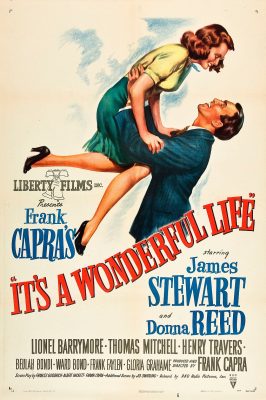 The 2022 holiday season marks the 76th Anniversary of It’s a Wonderful Life. Based on Philip Van Doren Stern’s short story The Greatest Gift, the 1946 Frank Capra film tells the tale of a despondent man (James Stewart) who contemplates suicide on Christmas Eve. His guardian angel grants him a chance to see what life for his friends and family would be like if he had never been born. Although a now a holiday favorite, the film was a box office flop and a major blow to director Frank Capra’s reputation.
The 2022 holiday season marks the 76th Anniversary of It’s a Wonderful Life. Based on Philip Van Doren Stern’s short story The Greatest Gift, the 1946 Frank Capra film tells the tale of a despondent man (James Stewart) who contemplates suicide on Christmas Eve. His guardian angel grants him a chance to see what life for his friends and family would be like if he had never been born. Although a now a holiday favorite, the film was a box office flop and a major blow to director Frank Capra’s reputation.
Indeed, this movie might have been a forgotten footnote in film history if not for a filing error with the U.S. Copyright Office. Then-copyright owner Republic Pictures missed filing the renewal application, causing the film to lapse into the public domain. This oversight enabled TV networks, who were looking for cheap holiday-oriented content, to program it heavily for more than two decades without paying any royalties to its producers. It was during this near-constant airplay that the film was rediscovered by the American public – earning its status as a holiday classic.
So how did this happen? The The US Copyright Act of 1909 governs copyrightable works created before 1964. The Act created two distinct copyright terms for each individual work: a 28-year initial term and a 28-year renewal term. The initial term applied automatically, but the copyright owner had to file a renewal application with the U.S. Copyright Office to acquire the second term. If the owner failed to file a renewal application before the first 28-year term expired, the work automatically entered the public domain. This was the case in 1974, when 28 years had passed, Republic Pictures failed to file a renewal for the film’s copyright protection. The upshot of this was that since the film was in the public domain, anyone could show the film without obtaining permission or paying royalties.
However, in 1993, Republic Pictures claimed that although they had failed to renew copyright over the film in 1974, they still retained rights to the original story, The Greatest Gift, (available in most public libraries) upon which the screenplay for It’s a Wonderful Life is based. As a backup, in 1993, it purchased the rights to the film’s musical score by Dimitri Timokin from his family, which had been copyrighted separately. Relying on the Supreme Court case Stewart v. Abend, 495 U.S. 207 (1990), which held that only the copyright owner of a story has the right to exploit derivative works such as films, Republic Pictures regained control of the picture.
Equipped with the Supreme Court decision concerning the underlying story and with the copyright in the music for the film’s soundtrack, Republic Pictures alerted all television networks to stop playing It’s a Wonderful Life without the payment of royalties. They then entered an licensing arrangement with NBC, where It’s a Wonderful Life is shown a few times each December. Others may also license the film for broadcast. On the local front, you can catch a viewing on the big screen at Cinestudio, located on the campus of Hartford’s Trinity College from December 19th – December 24th.
The film’s days of 24 hour free programming may be over, but thanks to the film’s revival from those those decades of repeated airplay, It’s a Wonderful Life gained a new cult status. It is now available for streaming on Amazon Prime, making it poised to capture the next streaming video audience. The film’s message of kindness, community and hope is timeless. Thankfully, a new generation can now receive Capra’s message anytime, on demand.